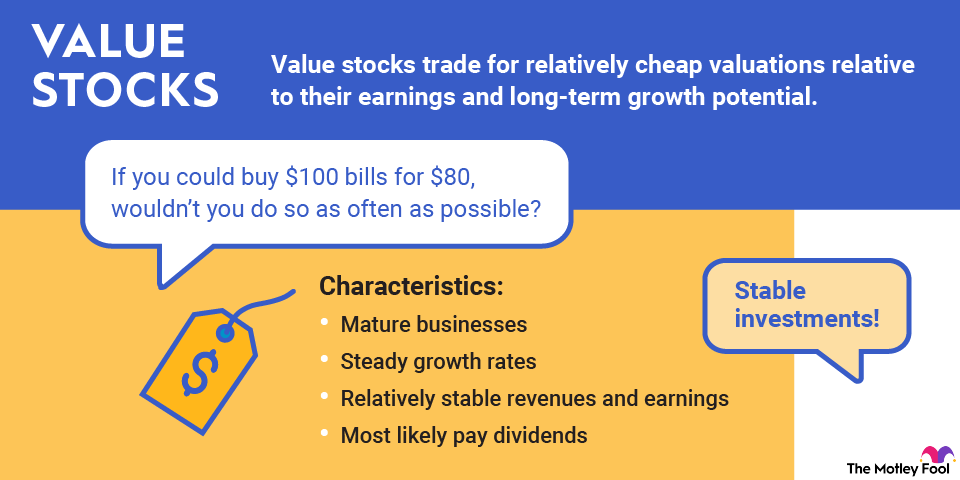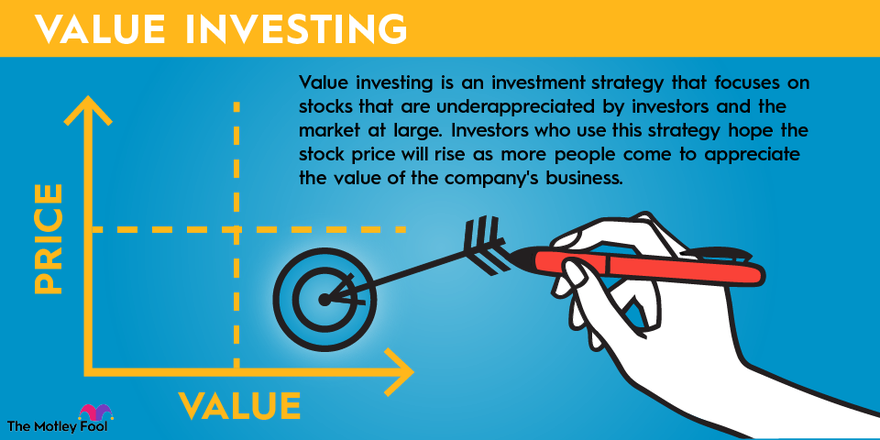Value investors want to buy stocks for less than they're worth. If you could buy $100 bills for $80, wouldn't you do so as often as possible? Even high-quality companies with strong fundamentals see share prices fall when the overall stock market drops. Plus, value stock companies tend to be well established and less volatile than growth stock companies.


NYSE: BRK.B
Key Data Points
Since Buffett took over in 1964, Berkshire Hathaway has grown into a conglomerate with more than 60 wholly owned businesses and a massive stock portfolio of more than 30 different holdings. Berkshire has steadily increased its book value and earnings power over time.
It operates under the same business model that has led the stock to almost double the annualized return of the S&P 500 index for more than 55 years. That track record is unmatched and will probably never be beaten.
As part of their value investing strategy, Buffett and his late business partner Charlie Munger kept large cash reserves to deploy when they spotted an opportunity. Buffett's also been content to own companies outright that can generate profit and don't need to grow, using those profits to fund stock purchases and new acquisitions, a unique strategy in the stock market.
Wholly owned subsidiaries, such as See's Candies, Dairy Queen, and Brooks running shoes, are all good examples of cash-flowing stable businesses that don't need to grow to contribute to Berkshire's business model. Buffett's value investing approach also explains why he favors sectors like insurance, which provide a "float" in the form of premiums that he can reinvest.
Buffett announced at Berkshire's annual shareholder meeting in May 2025 that he would step down by the end of the year. He will be passing the reins to Greg Abel, who is currently CEO of Berkshire Hathaway Energy.
As of the end of the third quarter, Berkshire had more than $375 billion in cash and equivalents on its balance sheet, putting it in a good position to make an acquisition if it finds one attractive. Additionally, the company could pay a dividend. Abel is expected to run the business with a value-oriented mindset similar to Buffett's, though the Buffett imprint is likely to change over time.
One sign that even value stocks are getting expensive is that Berkshire was a net seller of stocks in 2024, signaling that Buffett may believe the market is overvalued. Stocking up on dry powder is another smart strategy of value investors like Buffett, and it will likely pay off if stocks pull back again as they did at the beginning of 2025.
2. Target
Target is one of the largest retailers in the U.S. and one of only a handful of national multicategory retailers, along with Walmart (WMT +0.23%), Costco (COST -0.13%), and Amazon (AMZN +0.16%). The company has been a steady engine of growth throughout most of its history. It has a wide reach for a brick-and-mortar retailer -- operating in urban, suburban, and rural locations -- and stores in all 50 states.

NYSE: TGT
Key Data Points
However, Target has struggled in recent years due to weak consumer discretionary spending, inventory fluctuations, and internal issues such as theft. It's also faced customer backlash due to changes in its diversity, equity, and inclusion (DEI) policies, which may have contributed to a weak first half in 2025. As a result, the stock traded at a price-to-earnings (P/E) ratio of 10.6 as of November 2025.
That's a great price to pay for a retailer with differentiated positioning and one that's still opening new stores despite its recent struggles. Target is also a Dividend King with a dividend yield of 4.9%, offering a reward to income investors.
Target still has a long-term growth opportunity in retail, both through new stores and e-commerce. This includes its range of same-day fulfillment options, such as curbside pickup, known as Drive Up, and same-day delivery through Shipt.
Target's stock has fallen for a number of reasons, but its challenges are fixable. The company expects to grow sales by a total of 15% over the next five years, and at its current valuation, the stock looks like it should be a winner if it can accomplish that goal.
While its recent results have been disappointing, Target is the kind of value stock that offers value because of its turnaround potential. A change in leadership could also help drive a recovery when Chief Operating Officer Michael Fiddelke becomes CEO in February.
3. General Motors
Valuation is arguably the most important test of a value stock, as a value investor is ultimately looking to buy a stock worth more than its price. As Buffett has said, "Price is what you pay. Value is what you get."

NYSE: GM
Key Data Points
By that yardstick, General Motors (GM) may be one of the best value stocks around. GM has been a leading player in the auto industry for a century and remains one of the world's largest automakers.
Based on its adjusted earnings per share (EPS), GM currently trades at a P/E ratio of 7. This is a reflection of investors' low growth expectations and uncertainty around tariffs and trade, which are expected to weigh on results this year.
The company has started to benefit from slowing growth in electric vehicles (EVs), though it has a number of them on the market, as the transition will support sales of its combustion vehicles. GM also announced in late 2024 that it would end its Cruise autonomous vehicle business, which had cost it an estimated $10 billion. Investors responded positively to the move because it will help GM's cash flow.
Concerns about tariffs have also pushed the stock lower, but it's unclear how the import taxes will affect the business since higher car prices could be good for GM, or at least for its American-made inventory. A recent hike in steel tariffs to 50%, however, is expected to be a hardship for GM and its peers.
The company estimates the gross tariff impact for the year to be $3.5 billion to $4.5 billion. However, the company will benefit from a new government MSRP offset program that lowers the tariff impact.
As a value stock, GM is also able to aggressively repurchase stock to lift its EPS. It has reduced shares outstanding by almost one-third over the last 18 months. That's one way value stocks can grow profits even without growing revenue.
4. Signet Jewelers
Signet Jewelers is the world's largest diamond jewelry retailer. With a market cap of just $4.1 billion, it's much smaller than any of the other stocks on this list, but value stocks come in all sizes.
Signet operates in a mature industry, and the stock has historically traded at a discount because investors regard it as a low- or no-growth company. There also seems to be some concerns about disruption from lab-grown diamonds.
However, Signet is benefiting from that segment as well since it's driving up average unit retail prices and giving the company new ways of serving a broader range of price points. It's also driving higher demand in the fashion category, which is the non-bridal segment of the business.
The company has made some smart moves, including reducing its real estate footprint, investing in higher-margin service businesses, like repair and warranties, and focusing on driving returns for its largest brands, including Kay, Jared, and Zales.
Based on adjusted EPS, Signet trades at a P/E ratio of just 10, and the company has taken advantage of that discount to buy back stock. In the first half of 2025, it repurchased 8% of shares outstanding after shares fell sharply, and its shares outstanding have fallen by roughly half over the last decade.
What are value stocks?
Most stocks are classified as either value stocks or growth stocks. Generally, a value stock trades for a lower price than its financial performance and fundamentals suggest it's worth. A growth stock is a company expected to deliver above-average growth compared to its industry peers or the overall stock market.
Growth Stock
Some stocks have both attributes or fit in with average valuations or growth rates, so whether they are value stocks depends on the number of pertinent characteristics they possess. Value stocks generally have the following characteristics:
- They are typically mature businesses.
- They have steady (but not spectacular) growth rates.
- They report relatively stable revenues and earnings.
- Most pay dividends, although this isn't a set-in-stone rule.
Some stocks easily fit into one category or the other. For example, package delivery giant FedEx (FDX +0.09%) is clearly a value stock that's fallen out of favor with Wall Street due to some short-term challenges. Conversely, fast-moving Tesla (TSLA +0.10%) is an obvious example of a growth stock.
On the other hand, some stocks can fit into either category. For example, there's a case to be made either way for tech giants Apple (AAPL -0.68%) and Microsoft (MSFT +0.43%), though their valuations may be a little too stretched currently to be seen as value plays.
Regardless of a stock's category, economic downturns present an opportunity for a value investor. The goal of value investing is to scoop up shares at a discount, and the best time to do so is when the entire stock market is on sale; for instance, during a recession.
Don't underestimate the power of value stocks
While they may not be quite as thrilling as their growth stock counterparts, it's important to realize that value stocks can have just as much long-term potential, if not more. After all, a $1,000 investment in Berkshire Hathaway at the beginning of 1965 would be worth more than $28 million today.
Finding companies that trade for less than they are truly worth is a time-tested investment style that can pay off tremendously.




